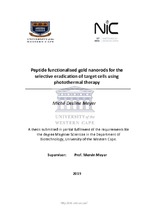| dc.description.abstract | Cancer is one of the leading causes of death, worldwide. Mortality tolls are estimated to reach approximately 13.1 million in 2030. These statistics suggest that current therapeutic strategies are not effective. This is partly due to the fact that the drugs used in the treatment of cancer lack selectivity and specificity, which lead to undesirable side effects and reduced drug efficacy. There is therefore a need for alternative therapeutic approaches. In view of this, the therapeutic goal of chemotherapy has shifted towards targeted drug delivery systems, which have been successfully demonstrated using nanotechnology. The nano-based drug delivery vehicles that specifically target diseased cells are appealing as they could reduce drug toxicity towards healthy tissues and be more effective at lower dosages.
The main aim of this study was to develop gold nanorods (AuNRs) capable of inducing cell death in cancer cells specifically. Selectivity of the AuNRs (denoted as AGK) for cancer cells was achieved by conjugating the AuNRs to a peptide (Adipose Homing Peptide or AHP) that has high affinity and specificity for a cell surface receptor (prohibitin or PHB) that is expressed on some cancer cells. Cell death was achieved through conjugating the AuNRs to a pro-apoptotic peptide, D(KLAKLAK)2. Spherical AuNPs (AuNSs) conjugated with AHP and D(KLAKLAK)2, capable of selectively inducing apoptosis in cancer cells that express PHB, was previously reported. However, in this study the AuNSs were replaced with AuNRs.
AuNRs has the ability to absorb light in the near infrared (NIR) light spectrum and converts this light energy into heat. This property of AuNRs has been used in several studies to demonstrate the application of AuNRs for the treatment of cancer using photothermal therapy (PTT). Consequently, the AuNRs described in this study can also be used for PTT. These AuNRs can induce cell death through the target specific delivery of the pro-apoptotic peptide D(KLAKLAK)2 as well as through PTT. The study showed that three human cancer cell lines (PC-3, Caco-2 and U-87) express PHB. The cytotoxicity testing of AGK AuNPs on PC-3 cells showed that these AuNRs could
induce apoptosis in these cells without exposure to a NIR light source. The study also shows that AuNRs conjugated with the targeting peptide only (denoted as AG) can induce cell death in Caco-2 through PTT. This study demonstrates the potential of the AuNRs described in this study for application in the targeted elimination of cancer cells through the selective induction of PTT and apoptosis. | en_US |

